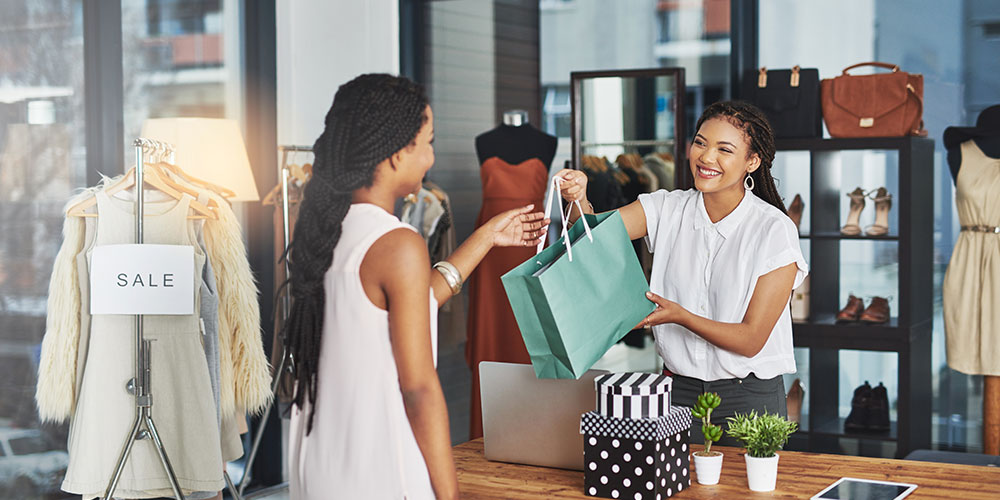Even through the height of the COVID-19 outbreak in the United States, many retailers have remained open as “essential” businesses. Grocery stores, drug stores and other establishments provide goods to the public with amended safety practices to maintain social distancing and limit exposure to the virus.
Meanwhile, some establishments temporarily closed to weather the storm of the virus, and others are slowly reopening with special plans in place to keep employees and customers safe.
No matter where you fall on that spectrum, statistics show that Americans are ready to buy from your business: After an average dip in retail sales across sectors between the beginning of 2020 and April, retail has begun trending upward once again.
As your business remains open or prepares for re-entry, how are you planning to maintain safety and cleanliness in your store? Not only is it your responsibility as a business owner to protect employees and customers, research proves that consumers are actively choosing to shop with retailers who prioritize health and safety.
Luckily, your security system can actually bolster health and safety measures within your retail establishment, making re-entry easier than you imagined.
Below, we’ll review all the ways your security system can do double duty: Secure your store, while helping you fight infection.
Enforce Safety Precautions With Surveillance
You’re already used to having video cameras installed for crime prevention and to enable remote monitoring. But did you realize that the same surveillance equipment can help you enforce safety precautions that prevent illness?
Use your surveillance cameras’ video analytics function to help you with smarter space planning. For example, track where customers might be gathering—and risking a lack of appropriate social distance—then rearrange your store as needed to enable a safe amount of space between customers.
For many retailers, the best way to ensure each customer has ample space inside the store is by limiting the number of shoppers inside at a time. However, people should still maintain a safe distance while they line up outside. Use your outdoor cameras to check in on customers outside and determine whether they need a reminder about your social distancing guidelines.
Additionally, use your indoor security camera infrastructure to check in periodically and ensure employees and customers are following the safety precautions you’ve enforced, such as wearing a mask or staying out of restricted areas.
Where to Add Surveillance Cameras
If you’d like to enhance your retail establishment’s video surveillance, upgrade or add to the video cameras you’ve installed.
Install security cameras in the following areas:
- Near targets for theft and burglary, such as electronics or other high-value inventory.
- Facing entrances and exits, including employee-only points of entry.
- Above points of sale (POS).
- With visibility onto your outdoor property, including walkways.
- In employee break rooms.
- Inside stock rooms and/or above inventory.
Make sure you’re aware of the laws in your jurisdiction for camera placement. Don’t install cameras anywhere people have a reasonable expectation of privacy, such as inside dressing rooms or restrooms.
How to Choose New Surveillance Cameras
If you need to add new cameras to achieve optimal surveillance, start by considering whether your cameras should be hard-wired or wireless.
If your budget is extremely limited, if there are multiple cable runs that exceed the limits of a traditional wired network or if you already have an existing analog infrastructure in place, you could consider an HD over Coax (also known as HD Analog) setup.
HD over Coax refers to the transmission of high-definition video and audio streams over coaxial cables that have traditionally been limited to standard quality video. This technology supports high-definition cameras, is typically lower cost and doesn’t need to operate on your network.
However, IP cameras are a higher-tech, digital option if you need a higher resolution or require a specialty type of camera, such as ruggedized, 360-degree and thermal cameras.
Before deciding which option is best for your business, evaluate resolution necessary on a per-camera basis. Understand the overall purpose of the system and the video quality needed.
To help yourself decide which camera is best for your needs, ask yourself the following questions (keep in mind that about 20 pixels per foot of an object in the scene is acceptable for basic surveillance, while 100 pixels per foot or more may be required for identification):
- Are you looking to capture details as opposed to a general overview of an area?
- What frame rate (images per second) do you require?
- What existing hardware and cabling is in place?
- Do you have enough bandwidth to support the system?
- Will your budget support system and software updates?
Understand Video Storage Options
There’s a crucial component to choosing surveillance cameras: considering where the footage will be stored.
Most often, surveillance footage is stored via a traditional network video recorder (NVR) or on the cloud.
An NVR is the physical device that processes and stores video signals from a security camera. When video is recorded, the IP camera converts it into a digital information that is sent to the NVR over a local IP network. NVRs require a clean, temperature-controlled setup on-site. If you manage a multi-site business, each location will require its own NVR. Cloud access options are available to provide the convenience of mobile app control and convenient viewing of video from a web browser.
With cloud storage, the video recordings are sent to a secure storage host on the internet. This typically means fewer components at each site, simplifying installation and potentially saving money. To access the video, you’ll use a unique login. Cloud-based solutions can be controlled from multiple devices, including your smartphone, computer or tablet.
Accommodate Shoppers’ New Preferences
Retail hasn’t ceased while the world copes with the pandemic—it’s adapted. By creatively approaching health and safety requirements, consumers and business owners have found new ways to support retail businesses.
By now, shoppers expect health-focused accommodations, and there’s a good chance these preferences won’t cease even after the pandemic has passed. In fact, McKinsey reports that 77% of Americans have adopted new shopping behaviors during the crisis, with the intention of sticking with them in the long-term.
As your business shifts to accommodate these preferences, rely on your security system to maintain the health and safety of your customers and employees.
Curbside Pickup
If you’re offering curbside pickup, employ the use of outdoor security cameras to keep an eye on the process. With employees leaving the store and approaching strangers’ vehicles to hand off purchases, there is an increased risk for theft and other incidents.
The presence of security cameras could deter criminals, and weather-safe cameras with a resolution of 100 pixels per foot or more can help identify any people involved in wrongdoings.
Touchless Payment
Many retailers have invested in technology that enables touchless payment, which goes a long way toward limiting contact between individuals.
It’s defined by Investopedia as follows: “The term contactless payment refers to a secure method for consumers to purchase products or services using a debit, credit, smartcard, or another payment device by using radio frequency identification (RFID) technology and near-field communication (NFC). This payment method works by tapping a payment card or other device near a point-of-sale terminal equipped with contactless payment technology.”
Without the need to pass cash back and forth or swipe a credit card in a contaminated reader—not to mention the sheer convenience—you can probably see why contactless payments rose 150% in the United States between March 2019 and June 2020.
However, with increased digital technology comes the responsibility to maintain updated PCI compliance practices. Standard PCI compliance centers around general data security to protect consumers, but evolving mobile payment options bring a new suite of considerations.
Stay informed on PCI standards and always keep your business practices in compliance to avoid a breach—and a legal nightmare.
Online Offerings
Many retailers pivoted to offer more or all of their inventory online, with shipping options, to appeal to consumers who aren’t comfortable entering physical stores. While this option is incredibly convenient for shoppers, the online presence might mean you have to increase inventory to accommodate the number of orders.
Protecting inventory is an age-old priority for retailers, but if you’ve suddenly expanded your inventory, your security system may need to adapt. Here are a few tips:
- Use surveillance cameras wherever inventory is stored. From the moment it enters your store to the moment it’s shipped out, you should have “eyes” on it with surveillance cameras.
- Install motion sensors in your inventory storage area. Motion sensors are triggered by movement and can link up with lighting, surveillance cameras and notifications on a mobile app, so you’ll always know when someone is accessing goods.
- Utilize access control technology. By limiting who can access inventory, you decrease the number of people who could steal.
Safeguard E-Commerce
As we’ve covered, consumers are shopping online more due to the pandemic—retail websites saw nearly 22 billion visits in June 2020, an increase of more than 5 billion visits from the beginning of the same year, according to Statista.
Part of readying your business to enable e-commerce is safeguarding against hackers and data theft. In the event of a breach, the responsibility to recover information and alert customers falls on the business owner. Especially if you operate a small business, the costs associated with responding to a cyber attack could be catastrophic.
As you gear up for more internet-based selling, follow these general tips to avoid falling victim to hackers:
- Always use a secure network. Unsecure networks leave open access points in your system, making it easier for hackers to compromise your sensitive business data.
- Protect your router. Your wi-fi router could come equipped with a reset button that can remove your security settings, so it should stay locked away. Not only that, protect your router by changing its default username or password (which can easily be found on the internet) to something more secure.
- Use multi-factor authentication wherever possible. Enable multi-factor authentication when logging into your website management platform, unlocking your POS terminal or any other function in your retail environment. Multi-factor authentication is a security enhancement that requires more than one credential when logging into an account, such as a password and an automatic texted PIN, and it adds an extra layer of security that’s difficult to hack.
- Secure all of your Internet of Things (IoT) devices. A good rule of thumb is that if a device connects to the internet, it can be hacked. For that reason, secure all of your IoT devices with unique passwords. That includes POS tablets, inventory scanners and other handheld devices, wireless speakers, smart TVs and more.
- Keep software and electronic devices updated. Automatic updates typically include safety features like anti-virus patches and other improvements that can keep your devices and network free from intrusion.
- Train your employees. Cyber security should become a tenant around which you run your business, and therefore should be integrated into employee training and communication. Employee negligence could cause a huge issue if it leads to a breach.
These tips are only the beginning. Cyber security must become a top priority for business owners in every industry, and it’s crucial to stay on top of cyber security news and updates.
Increase Employee Safety
Safe and healthy employees are the backbone to keeping your retail business running. During times of heightened awareness around health, it’s comforting to know that your security equipment can offer your team peace of mind.
Here are just a few ways.
Check Skin Temperatures
Access control technology offers a multitude of security safeguards. Aside from controlling who can access certain parts of your business, biometric access control and thermal video cameras can be deployed at checkpoints and other key areas to detect elevated skin temperatures and identify at-risk individuals.
You can also integrate facial recognition with temperature detection in larger retail operations to automatically identify personnel and forward confidential alerts for further action.
This type of detection can allow for earlier discovery, reporting, isolation and treatment—avoiding larger scale outbreaks that could pass to shoppers and the community at large.
Use Touchless Entry Throughout Your Business
Another, more obvious use for access control is enabling touchless entry for your employees to access break rooms, stock rooms and employee entrances without actually coming in contact with high-touch surfaces like doorknobs and keypads.
Access control enables contactless entry by requiring employees to wave a key fob, swipe card or other device in front of a sensor, then automatically opening a door.
Not only does this minimize germ transfer through high-touch surfaces, it can allow for easy contact tracing if there is an outbreak. You can access records to see which employees were in a certain room together and could have been exposed to a sick coworker.
Manage Deliveries and Vendors Safely
Retail businesses regularly intercept deliveries of inventory and other essential items for their stores, as well as interacting with general business vendors. For the employees who need to manage these outside people, it could mean unsafe exposure to germs.
To minimize exposure, allow employees to access your security system’s two-way intercom and video capability. If you have surveillance cameras and audio devices at your business’s entrances, employees can see who’s there, talk to them, and instruct them to leave deliveries at the door.
Also, if you’ve enabled smart locks with remote access, your employees can unlock the door for vendors and other personnel, watch them unload deliveries through video surveillance and then lock the door once they’ve left—all from a mobile device.
With these protocols in place, your business functions as smoothly as normal without increasing the number of people coming face-to-face.
Maintain Retail Security Best Practices From Afar
While your retail business navigates re-entry, there may be times you have to manage operations from afar—perhaps due to employee illness, regional health mandates or other extenuating circumstances.
No matter the situation, you should be prepared to keep your brick-and-mortar retail operation safe and secure. This is all possible with a security system that enables remote access.
With a business security app, you can use your smartphone or tablet to:
- Manage heating and cooling to maintain lower energy consumption.
- Check in on a live feed of your security cameras.
- See a log of remote access activity.
- Receive notifications from motion sensor or alarm triggers.
- And much more.
Not only that, if your security vendor offers access to a 24/7 monitoring center, you’ll have an added layer of protection for your business. Monitoring centers work to verify threats and dispatch the appropriate personnel in case of a true emergency. That means your business is protected without you ever having to call 9-1-1.
Partner With a High-Quality Security Vendor
To give your retail business the full protection it requires as you navigate re-entry, a high-quality, professionally installed security system is a necessity. Your security vendor can help you determine the best way forward for a safe and healthy retail environment.



